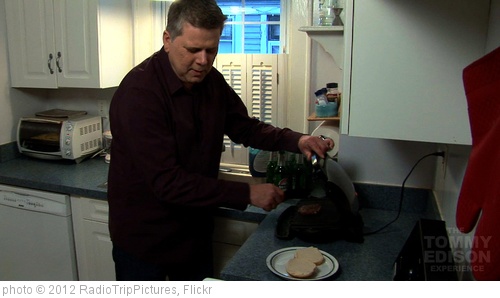 The Kitchn contacted me for tips on cooking with disabilities in light of my post, Ten Tips for Cooking with a Disability or Injury. Since only a few were featured, I am sharing the rest with you.
The Kitchn contacted me for tips on cooking with disabilities in light of my post, Ten Tips for Cooking with a Disability or Injury. Since only a few were featured, I am sharing the rest with you.
The Kitchn: Can you tell me about your mother’s disability, and how you had to step in to help? How did your mom’s disability change both of your lives in the kitchen?
Cooking Manager: I worked alongside my mother in the kitchen from a young age. She loved to try out new techniques, gadgets and recipes, and gave me more responsibility to teach me independence as I got older. When she eventually needed my help it didn’t feel like a burden.
When I was about 13 my mother was diagnosed with rheumatoid arthritis, a degenerative, auto-immune disease characterized by painful and swollen joints. I believe she viewed her disability as a new cooking challenge. My mother had me take over some of the work that she found difficult, like rolling out dough, sifting or taking heavy casseroles out of the oven.
My mother needed to be self-sufficient as I would soon go to college. I was no longer living at home when my mother died, but I’m sure she prepared a well-balanced, piping-hot and perfectly cooked meal until her last day.
TK: A lot of people talk about accessible design in terms of architecture or gadgets, which can be important, but I love how your post addressed methods and techniques. What would you say are 3 of the most important strategies?
- CM: Plan ahead. While planning saves time, money and hassle for every home cook, it is crucial for those with disabilities. An accident like a broken glass or missing ingredient might leave a disabled person without anything to eat. Make careful shopping lists, and build leeway into your cooking schedule. Work with small quantities, saving bulk cooking for days you have help. My mother’s homemade baking mix had to be sifted 3 times so she only attempted it when I was available. Then she could bake on the days I wasn’t home. Always keep food on hand for days you don’t feel up to cooking.
- Know your limitations. When a healthy person gets overtired, they usually recover after a few hours. But a person with a disability could end up spending the next day in bed or even in the hospital. Vary your activities, rest frequently, and stop before, or as soon as, you feel any strain.
- Focus on logistics. Look for big and small steps that can be skipped. My mother kneaded dough in the food processor. But if you prefer to make bread by hand, stretching it a few times and letting it rest in between is just as effective as heavy kneading. And some bread doughs don’t require kneading at all. You’ll want a chair or stool at a convenient height for your workspace and sharp knives. If you find yourself getting up frequently, think how you might combine trips. Improvements can be as simple as choosing foods made with one pot and a few ingredients, or clearing a larger workspace so you can have more items within reach. Learn how to chop or stir or lift without aggravating your disability. An occupational therapist, or an efficient friend, may be able to offer specific suggestions.
TK: Have you continued to employ any of the strategies your mom used, in your own cooking? In other words, sometimes challenges can inspire solutions that are helpful for everyone. Have you found this to be the case?
CM: My mother taught me to think about the little things because they add up—whether cooking tasks, water usage or waste. As a mother of six and a breastfeeding counselor I know that a lot of moms get overwhelmed by cooking after their children were born. Most strategies I recommended can work for all busy people. Since most of us aren’t prepared to spend as much time cooking as they did in previous generations, efficiency techniques can make the difference between cooking from scratch and eating take-out.
TK: Do you have any tips for family members or friends of people with disabilities — how to help your loved ones in the kitchen from a practical and emotional standpoint?
CM: When someone has a disability it’s tempting to jump in and take over. Friends and family need to respect the autonomy of the disabled person. Think about the tasks that might be difficult and offer to help in a few specific ways. For instance, if you are going shopping offer to pick up some things or to take the person along. If budget allows, consider paid help or gadgets. Community services or volunteer organizations may offer assistance. Figuring out the best strategies is often a matter of trial and error.
Finally, we must always keep in mind to treat people with physical disabilities as capable adults. Respect their choices, privacy and desire for independence.
You can see The Kitchn’s post here: Cooking with a Physical Disability
Here are two more posts that I think will be useful for those with disabilities and their families:

Great tips for everyone, not just those with disabilities.
Thanks, Sharon!
Yes, yes and yes!